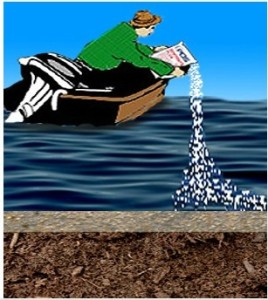 The Sprinkle Method for Bentonite Pond Sealant
The Sprinkle Method for Bentonite Pond Sealant
The sprinkle method is recommended only when it is not feasible to drain the existing pond or in cases of isolated leaks when a spot treatment may be a possible alternative.
This method is less effective than the other two methods for several reasons: Uniform and accurate placement of the bentonite is difficult and the pond bottom may include debris such as trash, vegetation, logs, rocks, etc., which may prevent sufficient coverage
If the bottom of the pond can be cleared, this method has greater chances of providing a good seal.
The granular grade of bentonite, Granular Seal (MSDS), is best suited for this method of placement. The granular bentonite should be used when using the sprinkle method because the particles are large enough to sink to the bottom, while finer particles cloud the water and stay in suspension. Begin by simply sprinkling the prescribed amount of granular bentonite (Granular Seal) on the water surface and allow it to fall into place. The granular bentonite particles will sink to the bottom of the pond or be drawn into porous areas where they will swell and reduce the seepage rate. “Granular Seal” weighs 1900 pounds per cubic yard. One-tenth of an inch of bentonite weighs six-tenths of a pound per square foot.
This method could possibly harm fish if the treatment is done during hot weather and at high rates of concentration. Although the sodium bentonite is not toxic, the tiny micro-particles of bentonite could attach to the fishes gills and cause them to suffocate due to lack of oxygen. Treatments during hot weather and in ponds that are low due to loss of water should be done over the course of several days and preformed on one portion at a time rather than treating the entire pond at the same time. This will minimize the hazard to fish in the pond.
Due to the many variables involved with the “sprinkle” method, such as depth and turbulence of the water, features of the pond bottom like vegetation, sediment, rocks, soil types, the “sprinkle” method is thought to be only 50% as effective at stopping leaks as the “blanket” methods where the bentonite is blended with the soil.
If you have an idea where the leak is originating from, such as a tree in the dam, big rock, or a layer of sand/gravel, treatment is recommended at up to five pounds per square foot of suspect area, when treating ponds with water in them.
The granules are to be scattered out as evenly as possible by the broadcast method, meaning that they may be slung out with a fertilizer spreader, or simply slung out of a gallon can or five gallon bucket.
This sodium bentonite is approved by the Corporation Commission and the EPA for the purpose of sealing ponds, and it shouldn’t harm aquatic life, however, due to the liability involved, the manufacturer states that the heavy treatment rates ‘may’ harm fish. The worst thing I have seen which may be considered harmful is a temporary “clouding” of small degree of water clarity which clears up quickly unless something is agitating the water, like cattle wading in ponds or heavy winds resulting in high wave action in shallow waters.
Unless the pond is built in very sandy soil, the area which is leaking is likely to be small and perhaps right where the dam meets the original undisturbed soil upon which it was built. Rock and gravel beds are also common which, when dug through, let the water percolate through their bedding plane and under the dam to surface behind the dam. Many ponds are built by persons who push large tree roots and/or limbs or whole trees into the dam as it is being built, which later rot and cause leakage.
To learn more about our products and to place your order, contact us by phone at 405-382-1973 or complete our online contact form.
